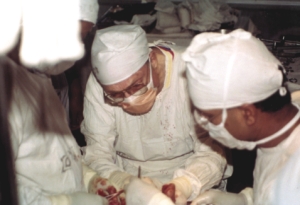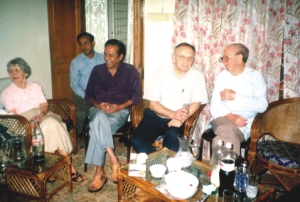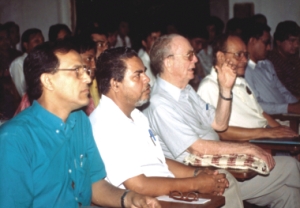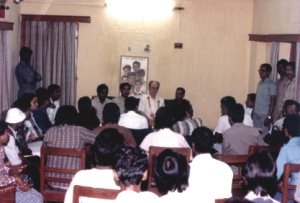|
Tribute A tribute to a true friend of Bangladesh
Dr Garst, an unsung hero of the Liberation War
Prof Dr M Amjad Hossain
We recall with gratitude the sacrifices of our brave freedom fighters and people in general for giving their lives for the independence of Bangladesh. But there are stories of unsung heroes also. Here is a story of a missionary who emerged as a saviour for many of our war-injured freedom fighters. He is Dr. Ronald Joseph Garst.
 |
| Dr Garst is performs a surgery while visiting the RIHD |
During our Liberation War in 1971, he was serving the distressed humanity at Ludhiana Christian Medical College in India. He was deeply moved to see the sufferings of the freedom fighters. He visited the war camps and began treating war-injured freedom fighters, many of them disabled by their wounds. His noble gesture drew the attention of the then special envoy of Bangladesh government in exile, Justice Abu Syeed Chowdhury.
In the meantime, Bangladesh became an independent state and Justice Chowdhury invited Dr Garst to visit Bangladesh. Garst's affection for war-wounded freedom fighters brought him to Bangladesh on February 28, 1972 accompanied by his wife Marie Garst. Patronised by the government, he set up makeshift rehabilitation camps for disabled freedom fighters at Mohammadpur College Gate near Shaheed Suhrawardy Hospital at Sher-e-Bangla Nagar.
As the glorious War of Independence had just ended, the hospitals throughout the country were filled with the victims of liberation war and the wounded freedom fighters. Seeing the untold misery of the victims Dr and Mrs Garst, put all their efforts in trying to solve this enormous problem. They met the then Minister, the Secretary and other high officials of the Ministry of Health who requested him to start an Orthopaedic Hospital and a central Limb and Brace Centre in the country to take care of all the liberation war veterans.
Garst immediately started his run of soliciting for funds and explained the needs of the new nation to the friendly countries. Responding to his call, many foreign countries and a good number of organisations came forward with generous gestures. Within one month, he was able to convert the Shahid Suhrawardy Hospital outpatient department into a Hospital with well-equipped OT facilities. There were only a hundred beds, which were barely sufficient to cope with the rush of patients. At the end of the second month the number of beds was raised to one hundred and fifty. Dr Garst started to survey the Cantonment Hospitals and District Hospitals around the country to find out the condition of the injured patients and arranged treatment facility for them in this hospital.
 |
| Dr Garst with Dr Halt, a pioneer spine surgeon and others |
Dr T Hussain the then Secretary of Health and Family Planning of Government of Bangladesh addressed Dr Garst and said to him, "Dr Garst, you equip and start a full-fledged Orthopaedic Hospital and Limb Centre and run them for one year, the Government of Bangladesh will then be able to carry it on with the project." This was a tremendous inspiration to him and his dedicated team.
Within eight months the majority of the war victims completed their treatment after which the door of the hospital opened to general patients with orthopaedic and trauma problems. This time another hundred beds were added for women and children on the converted roof of the Hospital building. Within one year an artificial limb and brace centre started functioning and many artificial limbs were supplied to the victims of the war of independence and freedom fighters. 1000 artificial limbs were made in the first year for the freedom fighters. On the 1st of July 1973 the major running expenses of the Hospital was taken over by the Government of the Peoples Republic of Bangladesh, now a two hundred and fifty bedded Hospital.
 |
| Dr Garst in an interactive academic session in the then RIHD |
It became obvious that in order to meet the enormous demand for treatment of the physically handicapped, the establishment of a separate Orthopaedic and Traumatology Hospital with adequately trained doctors and specialist was essential. Meanwhile with full co-operation of senior surgeons in the country and the Ministry of Health a plan was prepared to meet up all the requirements by the Overseas Development Ministry of England. The plan was passed by the authority in due time. Subsequently the overseas orthopaedic surgeons started to arrive in the country under the auspices of the Overseas Development Ministry of England. Several orthopaedic surgeons of different parts of the world started visiting the Hospital and its management. All of these measures made the total programme a unique one.
Dr Garst agreed to continue with the project in the country that provided the post graduate course he started under the University of Dhaka and the first post graduate course such as MS and Diploma in Orthopaedic Surgery and BSc (Physiotherapy) began in July 1973. By 1976 nine doctors (five MS and four D Orth) had completed their orthopaedic courses and thus a new group of specialist in the subject started their career. Twelve physiotherapists and three occupational therapists graduated with BSc degrees. Twelve graduate nurses completed one year training in orthopaedic nursing. Twenty-six young men had been trained in a three-year course of artificial limb and brace making. Thus the year 1976 was the year of grand achievement of Orthopaedic Surgery in Bangladesh so far.
By this time the capacity had reached three hundred and seventy five by the addition of seventy-five beds in the casualty ward. The overcrowding of hospital beds and the overall programmed activities were running in a two-storied outpatient department building including its roof. Admission of women and children patients necessitated further spatial expansion and compelled everybody to think of a regular hospital. In 1974 the NEC of Bangladesh approved the plans of RIHD and Dr R J Garst was honoured with the post of Project Director of the proposed hospital complex to be established at Sher-E-Bangla Nagar, Dhaka the new capital of Bangladesh. Initially this complex was named Shaheed Suhrawardy Hospital Complex and Dr Garst was honoured with a salary of Taka one, equivalent to 7 cents!
He set up the library of the then RIHD by lots of orthopaedic books published since 1950 and it was Marie Garst who managed the library. Dr Garst always carried a typewriter with him to type whatever was necessary -- to avoid unnecessary hassle of making delays in the government official procedures.
 |
| Dr Garst (garlanded) at a reception hosted by the Shaheed Family and War Injured Freedom Fighters' Unit Command of Bangladesh Muktijoddha Sangsad in 1987 |
The contribution of Dr Garst to our country is enormous. He brought so many renowned orthopaedic surgeons from Britain, America, Canada, Singapore, and Hong Kong in our country in order to improve the standard of treatment. Eminent spine surgeon Dr Richard Holt came from Kentucky, US and developed the practice of spine surgery as a sub-specialty here. Prof Eyre Brooke and Prof Wilson came from the UK. Dr Kunda Pillay, of Mount Elizabeth Hospital, Singapore brought doctors from our country and trained them in orthopaedics there. He used to offer Bangladeshi doctors six-month fellowship training.
He was the first person to introduce the morning session of discussion at RIHD. All doctors of the institute took part in the session to discuss the work and experience of the previous day. The initiative was unique in our country. Now several institutes of our country follow this guideline for continuing medical education.
His philosophy was to spread the education among the poor and underprivileged people.
Garst always emphasised service to the poor. In his notepad he wrote -- 'God has sent me for a mission to help the suffering humanity of my community and the other community of the world.'
Garst stayed in Bangladesh till 1981 and rendered his selfless services to disabled freedom fighters and developed orthopaedic treatment facilities. Now this remarkable man lives in his small house at Tennessee in the United States.
He is a living legend in the history of Bangladesh. As recognition to his outstanding contribution to our country the Bangladesh government honoured the citizenship of our country in 1999. We should remember this laureate for his exceptional contribution to us. Our young generation, particularly the young doctors should follow a humble remarkable person like him.
The writer is Professor and Head of Department of Orthopaedics and Trauma Surgery of Dhaka Medical College Hospital who use to keep in touch with Dr Garst in USA regularly.
Copyright
(R) thedailystar.net 2006 |
